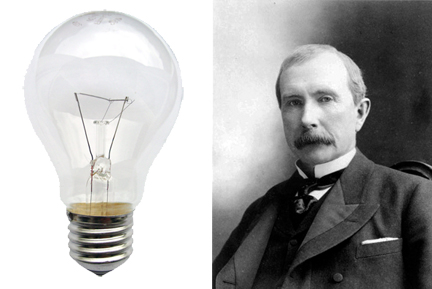 The next time you stop at a station and pump gasoline into your
car, I want you to remember that you are buying a product that used to be
considered a waste by-product and it was dumped by the millions of gallons at
refineries. That’s right, gasoline was once just thrown away. Think about that
as that little meter registers how much you are spending. How did gasoline go
from waste to one of the most sought after commodities in the world? It was all
about the bold moves of two business leaders that turned two industries on their ears.
The next time you stop at a station and pump gasoline into your
car, I want you to remember that you are buying a product that used to be
considered a waste by-product and it was dumped by the millions of gallons at
refineries. That’s right, gasoline was once just thrown away. Think about that
as that little meter registers how much you are spending. How did gasoline go
from waste to one of the most sought after commodities in the world? It was all
about the bold moves of two business leaders that turned two industries on their ears.
Let me take you to the last half of the 19th century
to the time of the industrial revolution. In 1893, the Chicago World’s Fair was
lit by a new and quickly emerging technology: the electric light bulb. Prior to
this, lights were fueled by kerosene. Kerosene was a product of crude oil
refining. It had replaced the more expensive whale oil that had been used to
light the darkness until the 1860s. At the heart of kerosene production was
John D. Rockefeller and Standard Oil. The discovery of oil in Pennsylvania and
his subsequent building of refineries had turned Rockefeller into one of the
wealthiest men in the world. His bold moves to corner the oil business, get it
delivered to market cheaply, and to control pricing to rub out his competition
is legendary. He did things no one else had ever thought of, like building
miles of massive pipelines to get crude oil from wells to his refineries.
The emergence of the electric light bulb threatened all of this
and the money man behind electricity was the financier J.P. Morgan. Morgan had
in mind to change the power industry. He bought out his closest competitors,
including the patents on AC electric generation and developed his own company:
General Electric. He was out to take Rockefeller’s wealth by wiring America.
Rockefeller had a big problem on his hands. His empire was soon
to be lost with the flip of a switch. He realized he could not stand in the way
of electrical expansion, so he decided to make another bold move and go in a
different direction. Gasoline, the very explosive and volatile by-product of
refineries, became his focus. At the same time that electrical lighting was
becoming popular, so was another new technology: the automobile with its
internal combustion engine. Rockefeller realized that this new technology
needed a fuel that was highly explosive to power its engines. The German, Karl
Benz, had powered a car with gasoline in 1886. Other autos were being driven by
steam engines and oil. But Rockefeller saw the potential for gasoline. He
invested heavily in gasoline production and used his influence to make sure his
product was the fuel of choice for the new automobiles. In 1896, Henry Ford
began to produce cars running on gasoline. Within 12 years, the Model T was
being mass produced. The demand for cars drove the demand for oil up just when
electricity was making kerosene lighting obsolete.
When is it a time to make a bold move and when are you just
steering off the road? First, you have to be keenly aware of your market.
Second, you have to understand what your competition is doing. Use these two
criteria to evaluate the demand for what you are selling. This is where a good
marketing plan comes into play. In marketing, we always want to sell your uniqueness,
but when the competition begins to do the same things at a cheaper price, you
need to make a shift. Understand that your uniqueness in the marketplace will
not last forever. There are always others who are coming behind you to
challenge your market position – or to make your product or service offerings
obsolete. When this happens, you need to break ranks and seek a new direction.
And in that seeking, many times you will find ways to reinvent your product
offerings and grow your business. Remember that the next time you pull up to a
gasoline pump.
___________________
Light bulb photo: Gluehlampe 01 KMJ by
KMJ, alpha masking by Edokter - de.wikipedia, original upload 26. Jun 2004 by.
Licensed under CC BY-SA 3.0 via Wikimedia Commons.